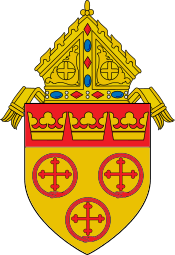Cathedral of the Epiphany (Sioux City, Iowa)
| Cathedral of the Epiphany | |
|---|---|
_from_SE_1.jpg) | |
 | |
| 42°30′3.28″N 96°24′25.13″W / 42.5009111°N 96.4069806°W | |
| Location |
1000 Douglas St. Sioux City, Iowa |
| Country | United States |
| Denomination | Catholic Church |
| Website |
www |
| History | |
| Founded | 1891 |
| Dedication | Epiphany |
| Architecture | |
| Status | Cathedral/Parish |
| Style | Gothic Revival |
| Completed | 1904 |
| Specifications | |
| Number of spires | Two |
| Materials | Brick |
| Administration | |
| Diocese | Sioux City |
| Clergy | |
| Bishop(s) | Most Rev. R. Walker Nickless |
| Rector | Rev. William J. Vit Jr. |
The Cathedral of the Epiphany in Sioux City, Iowa, United States, is the cathedral and a parish church in the Diocese of Sioux City.
History
The Cathedral of the Epiphany had its beginnings as St. Mary's Church in 1891. Rev. Timothy Treacy was the first pastor of the parish intended to serve the needs of a growing number of Irish and German immigrant Catholics in the central part of the city. However, construction of a new church was delayed because of the economic depression that hit the United States in 1893.
For the next 10 years, parishioners worshipped in the basement of the present church. When Pope Leo XIII established the Diocese of Sioux City in 1902, Bishop Philip Garrigan decided that St. Mary's Church would serve as the cathedral and began work to complete the upper church. He also sought permission from the Holy See to change the name of the parish.[1] Bishop Garrigan dedicated the edifice, without its signature spires, on September 8, 1904, as the Cathedral of the Epiphany.
The cathedrals stained glass windows are from the Mayer Company Studios in Munich, Germany.[2]
The towers were completed in 1961 in a building project initiated by Bishop Joseph Mueller. This same project completely changed the interior of the cathedral. A new marble altar with baldachin replaced the old wooden altar.
The most recent renovation project was in 1994 and addressed roofing, gutters, tuckpointing and other exterior issues as well as restoring many of the interior elements and decoration that were removed in 1961. St. Thomas Church in Emmetsburg, Iowa closed while work was underway in the cathedral and its altars and Stations of the Cross were donated to the cathedral as they are similar in style to those same items removed from the cathedral.
Today the cathedral parish continues to foster diversity as Masses are offered in English and Spanish.
Parochial School
In the 1940s, parishioners started talking about replacing their old school. The last graduation from Cathedral High School was held on June 1, 1949.[3] That fall Bishop Heelan Catholic High School opened and the Sisters of Charity of the Blessed Virgin Mary continued to teach at Heelan.
By 1957, it became obvious that both Epiphany and at Heelan needed new school facilities. The diocese held a fund drive was held and purchased three lots at the corner of Tenth and Douglas Streets for $40,500.[3] The new grade school was built on the site and opened in September 1959. The parish grade school closed when schools from Epiphany, St. Boniface and St. Joseph consolidated in 1987 to form Holy Family School.[4] The former school building, now called Epiphany Center, houses offices, parish center and religious education classrooms for the parish.[3]
Pipe organ
The Orgelbau Wech (2006) pipe organ is in a gallery-level case in the rear of the cathedral. It features a traditional style console with a mechanical action console that is detached from the main case. It is equipped with two manuals, 3 divisions, 31 stops, 29 registers, 37 ranks.[5] The manual compass is 58 notes and the pedal compass is 30 notes. The organ has slider chests, balanced mechanical key action, and electric stop action. The drawknobs are arraigned in horizontal rows on terraced/stepped jambs. There are balanced swell shoes/pedals. The combination action is a computerized/digital system. Rounding out the features are a flat straight pedalboard, reversible full organ/tutti toe stud, combination action thumb pistons, combination action toe studs, coupler reversible thumb pistons, and coupler reversible toe studs
Stoplist:[5]
HAUPTWERK Manual 1, 58 notes
|
OBERWERK Manual 2, 58 notes, expressive
|
Pedal
Accessories
|
References
- ↑ "History of the Diocese Of Sioux City". Diocese of Sioux City. Retrieved 2010-02-04.
- ↑ "History". Cathedral of the Epiphany. Retrieved 2010-02-04.
- 1 2 3 "Sioux City - Cathedral of the Epiphany". The Catholic Globe. Sioux City. Retrieved 2010-09-30.
- ↑ Lefebvre, Katie (August 7, 2008). "Parishioners take pride in St. Boniface Church" (PDF). The Catholic Globe. Sioux City. Retrieved 2010-09-30.
- 1 2 "Orgelbau Wech, 2006". Organ Historical Society. Retrieved 2013-08-19.
External links
![]() Media related to Cathedral of the Epiphany (Sioux City, Iowa) at Wikimedia Commons
Media related to Cathedral of the Epiphany (Sioux City, Iowa) at Wikimedia Commons
Coordinates: 42°30′03″N 96°24′25″W / 42.50091°N 96.406982°W
